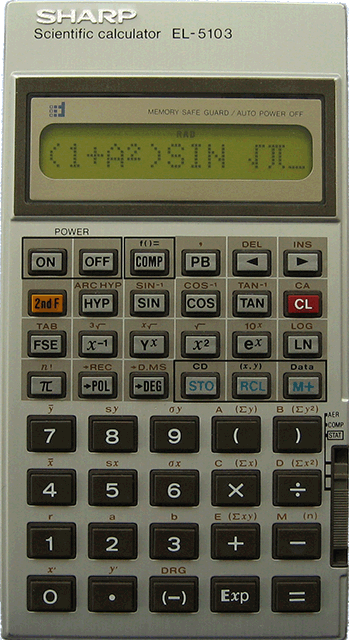sharp el-5103
| the el-5103 is probably sharp's finest pocket
scientific model and ahead of its time in many ways. its a fairly rare
machine appearing briefly in the gap between their older scientific
models like the el-512 and the later basic
programmable pocket computers like the pc-1251. a very nicely designed machine and a pleasure to use, small, slim and pocket sized. the buttons are excellent and the display is an alpha numeric, dot-matrix. this was a rarity in calculators of its time and the only other alpha capable machines nearby were the hp41c and casio fx-602p. the sharp's alpha capability is limited, however, because it is not truly programmable. the true purpose of the alpha numeric display is formula entry and in this regard makes this machine one of the earliest formula entry models. the formula expression evaluation of up to 80 steps is superb, with implied multiplication for brackets and number prefixes to functions. for example 2sin1, 2(3+√5) and 1÷2π all do the expected thing. rather than having an ans key (like today), the last expression can be recalled with PB (playback) and re-edited, then re-evaluated. this does create a difficulty because you cannot immediately operate on a previous result (like you might today press √ ans). although not truly programmable, several early and pioneering versions of expression programming are available. a selector switch chooses between AER (algebraic expression reserve) and COMP modes. these parallel the concepts of program and run modes on programmable machines. in AER mode a (single) expression of up to 48 steps involving variables A-E and M can be accommodated. on switching back to comp mode, the expression can be evaluated in terms of the current contents of the variables by pressing the COMP button. another variant allows an expression to be reserved as a function of given variables. for example f(AB) = √(A² + B²) defines a function of two unknowns A and B. in comp mode, the COMP button will prompt the user for values of the unknowns then proceed to evaluate the expression. this is a bit like the function library of the casio fx-5000f and fx-50f. the reserve expression can have multiple parts separated by comma. the rest of the features are a familiar set of scientific functions including hyperbolics and 2d stats. the stats is a special mode (on the switch) that reassigns the A-E memories to stats storage. |
 |
its is powered by 3 G-13 cells which last for a claimed 1,400 hours of continuous use.